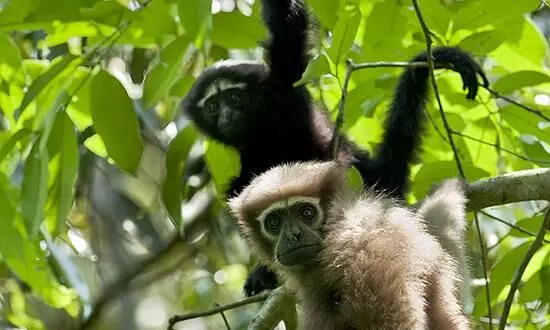Proposed oil exploration at Hollongapar Wildlife Sanctuary falls in RED category: NBWL
The guidelines issued by the MOEF & CC dated February 9, 2011, setting up of industries causing pollution has been placed in the prohibited category

Hollongapar Gibbon Sanctuary
Image Source: Internet
Guwahati, Nov 15: With the National Board for Wildlife (NBWL) Standing Committee deferring the proposal for oil and gas exploration in the eco-sensitive zone (ESZ) of Hollongapar Gibbon Wildlife Sanctuary, the undue haste exhibited by the Assam forest department and the State government stands exposed.
Significantly, the NBWL observed that the proposal falls in the RED category of polluting industries, and as per the ESZ notification of Hollongapar Gibbon Sanctuary and the guidelines issued by the Union Ministry of Environment Forest and Climate Change (MOEF & CC) dated February 9, 2011, setting up of industries causing pollution (water, air, soil, noise, etc.) has been placed in the prohibited category.
This makes it amply clear that setting up of such a highly polluting industry that has categorically been put in the prohibited category is likely to trigger serious and long-term fallouts for the wildlife sanctuary.
The threat to the sanctuary gets further amplified when the small size of the protected area is taken into consideration, together with the fact that within the sanctuary's 20.98 sq km area, it harbours the critically-endangered western hoolock gibbon and boasts of the country's highest primate diversity, accounting for eight species.
Conservationists and local stakeholders have also pointed out that the proposed oil exploration points in the ESZ as identified in the proposal lie in the heart of elephant territory.
According to the site inspection conducted by the divisional forest officer on April 9, there is evidence of elephant movement (dung and footprint) in and around the proposed site.
“The Principal Chief Conservator Forests (Wildlife) has stated to Forest Advisory Committee as per the meeting held on August 27, 2024, that the proposed oil exploration points have a significant presence of wildlife, which includes elephants and gibbons," Numal Chawra, Pinak Borthakur, Pinaki Sengupta and Prarthana Bordoloi - local stakeholders - mentioned in their memorandum to the NBWL. The petitioners also voiced concern that oil exploration activities would trigger a severe human-elephant conflict in the area.
An NBWL team is scheduled to visit the sanctuary situated at Mariani in Jorhat district in the next few days for a site inspection. The team comprises representatives of the MoEF & CC, Wildlife Institute of India (WII), State forest department and ecologist Dr Raman Sukumar.
A senior Assam forest official wishing anonymity told The Assam Tribune that a thorough assessment of the threats posed by the proposed oil exploration should have preceded its clearance by the State government and the forest department.
Shockingly, there was no public consultation by the project developer or any government agencies on the proposals related to both exploratory drilling and the railway track electrification in the eco-sensitive zone and inside the sanctuary, respectively. Hollongapar Gibbon Wildlife Sanctuary is the only sanctuary in India, which has been named after a primate. Its celebrated primate diversity apart, it also shelters wide-ranging species, including the Asiatic elephant, leopard, leopard cat, jungle cat, common palm civet, barking deer, sambar deer, Malayan or black giant squirrel, Chinese pangolin and Himalayan or Sikkim large-clawed shrew. Its avifauna is equally rich, with 219 species of birds recorded so far. Over 200 species of butterflies and a number of species of reptiles, amphibians and arachnids add to its biodiversity.
The Assam government had approved the oil exploration project by the Vedanta group near Hollongapar Gibbon Wildlife Sanctuary a few months back. The decision evoked criticism from environmentalists and local people.
-By Sivasish Thakur

